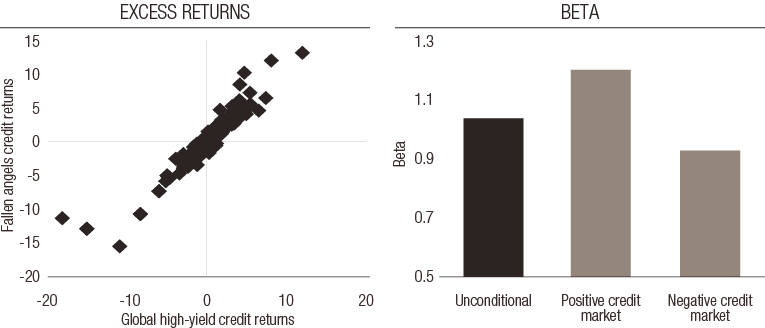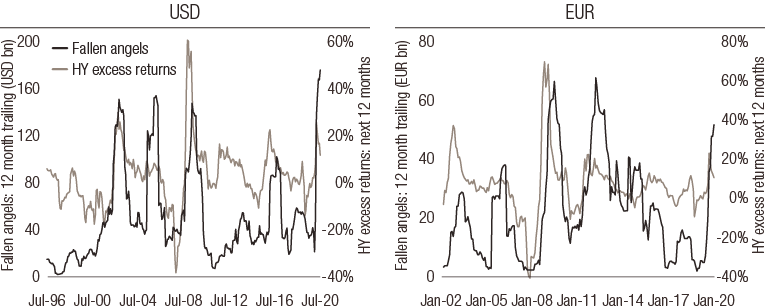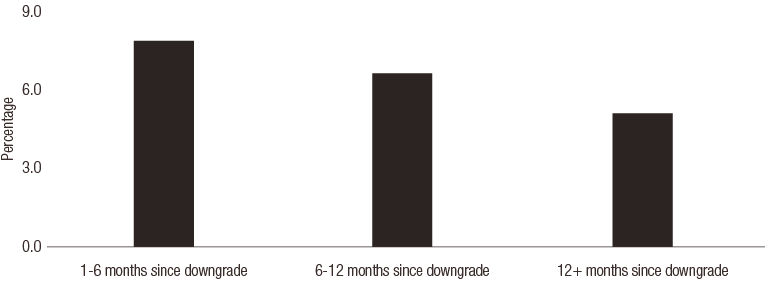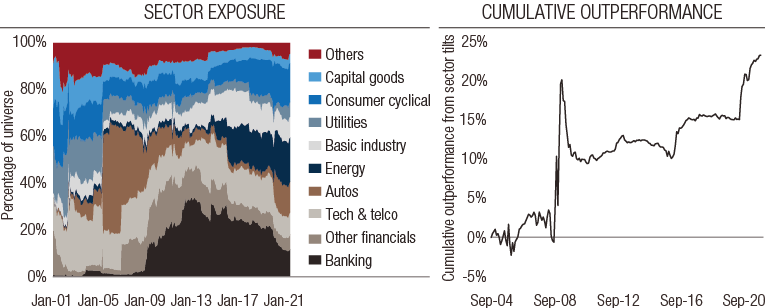investment viewpoints
Alphorum: think fallen angels for attractive high-yield convexity



In the sixth and final insight for the Q4 2021 issue of Alphorum, we share findings from our research on the performance characteristics of companies that have descended from investment-grade status – the so-called fallen angels of high yield – in different market environments.
Our research report follows earlier commentaries from this issue of Alphorum:
- Lead commentary: our CIO responds to the diverse financial, macro and sustainability risks and opportunities coursing through markets
- Developed market and inflation-linked bonds: from the US to Europe to Asia, narratives for hiking interest rates are solidifying or actually playing out
- Sustainable fixed income: real efforts to accurately capture the effects of environmental risks on credit performance should withstand accusations of greenwashing in a year of record sustainability-bond issuance
- Corporate credit: as markets acknowledge the imperfections of this recovery, spreads are widening in certain sectors
- Emerging markets: responses to the risk of inflation vary across the universe, while slowing but stable global growth supports sovereigns as the tailwind of healthy current accounts eases
For now, let’s return to our research programme, where our analysis of the performance patterns of fallen angels in different market environments shows how these issuers can provide investors with a source of high-yield convexity – an attractive characteristic for credit portfolios.
Fallen angels: a source of asymmetric beta
So-called ‘fallen angels’ are borrowers who have been downgraded from investment grade to high yield (usually from BBB to BB). Although the boundary between investment grade and high yield is somewhat artificial, the two universes tend to appeal to different classes of investors. More risk-averse and benchmarked investors often sell out of downgraded bonds, a tendency which has been fueled by the rise of passive indexation benchmarked to bond indices. This results in dislocations which are a potential source of outperformance.
A number of structural elements in the way that the fallen angels universe is formed, which we explore later in this piece, gear the asset class towards a greater exposure to credit market returns in recovery periods. One way to test exposure to different market regimes is to calculate conditional betas of the universe of fallen angels to the broader high yield universe. Panel B of Figure 1 shows the excess returns of the fallen angel universe when compared to the global high-yield credit universe, both unconditionally and conditional on up and down moves. As you can see, the unconditional beta is close to 1, indicating similar market exposures as the high-yield index over the full cycle. However, on the downside (during negative market returns) the conditional beta is 10% lower, while on the upside (during positive market returns) it is over 20% higher. Therefore, fallen angels provide a convex high-yield exposure – that is, they outperform in a recovery (while falling less in a selloff). This net positive convexity, also known as ‘asymmetric beta’, comes both from a reversal of price overreaction and from the increased exposure to recovering sectors which fallen angels provide.
FIG 1: Outperformance of fallen angels compared to global high-yield credit
|
A: Excess returns of fallen angels vs global high-yield credit |
B: Beta of fallen angels compared to global high-yield credit |
Source: Bloomberg indices, LOIM calculations as at September 2021. For illustrative purposes only.
Supply dynamics of fallen angels
Historically, the supply of new fallen angels is highly correlated with economic cycles. By definition, supply will peak in the downgrade cycle as credit-rating agencies react to stressed economic and market environments, a process that tends to lead the bottom of credit selloffs. As an example, the COVID-19 crisis generated a 12-month rolling supply of fallen angels in the US dollar market of USD 195bn, which, in absolute terms, is the largest ever recorded. European market supply was just shy of all-time highs at EUR 55bn. Largely as a result, the fallen angels universe currently stands at around USD 400bn in size.
This countercyclical uptick in supply increases the weight of ‘new’ fallen angels within the overall fallen angels universe just before credit market rallies, as shown in Figure 2. This is a very favourable dynamic, which can be exploited further through a relative-value approach.
FIG. 2: Fallen angels supply vs market returns
Source: Bloomberg indices, LOIM calculations as at September 2021. For illustrative purposes only
It is interesting to note that the ratings distribution of fallen angels has been relatively stable over time and has actually improved, with a greater proportion of BBs. What’s more, in contrast to high-yield, we expect the quality of the fallen angels universe to be counter-cyclical as a credit selloff should result in more BBs entering this segment.
The age of fallen angels as a factor in outperformance
Our analysis shows that a large part of the reversion in fallen angels is realised in the first year after being downgraded. This raises the possibility of overweighting newer fallen angels while being underweight aged ones. Figure 3 shows the average credit excess returns for fallen angels split by the length of time from downgrade. The one-to-six-months cohort outperforms but is also much more volatile. The six-to-12 months cohort also performs strongly but demonstrates lower volatility and a marginally higher Sharpe ratio. Finally, the 12-plus months cohort significantly underperforms the broad index.
The asymmetric beta angle is also more pronounced for newer fallen angels. The one-to-six months cohort exhibits a beta of 1.45 to market rallies, while their lower participation in selloffs is reflected in a downside conditional beta of 0.87. However, beyond a year from downgrade the effect fades, with fallen angels behaving broadly in line with their high-yield peers.
FIG 3: Average credit excess returns of fallen angels sorted by months from downgrade
Source: LOIM Calculations as at September 2021. Return and volatility figures are annualised. Conditional Betas calculated against excess returns of Global HY index. Past performance is not a guarantee of future results.
|
Summary statistics by time since downgrade
|
Playing the recovering sectors
While market overreaction and subsequent reversion in terms of individual borrowers is an important factor in outperformance, fallen angels tend to be just as much a sector-recovery play. Whole sectors that are under the greatest pressure tend to overreact, with that overreaction exacerbated for the fallen angels within that sector.
As shown in figure 4A, the largest sectors for fallen angels have shifted over time, reflecting sector-specific leverage cycles. The early 2000s saw a resurgence in technology and telecom fallen angels, while in 2005 the major downgrades of Ford and GM meant the auto industry dominated1. In 2008-09, the global financial crisis led to banking becoming the largest fallen angels sector, a position it held for over a decade until the Covid-19 crisis saw the auto and energy sectors come to the fore.
Consequently, the recovery of cyclically affected sectors contributes significantly to fallen angels. By reweighting sectors in the fallen angels index to be in line with sector weighting in the wider investment-grade and high-yield universes, we can see how the recovery of cyclically affected sectors contributes to the outperformance of fallen angels. In Figure 4B you can see the outperformance of the standard index versus the sector-matched index, indicating that sector composition in recovery periods contributes significantly to the strong performance of fallen angels.
FIG 4: Fallen angels: sector composition
Source: Bloomberg indices, LOIM Calculations at September 2021. Past performance is not a guarantee of future results.
Conclusion
A corporate bond universe bluntly split into distinct investment-grade and high-yield markets at the BBB/BB boundary has resulted in the unique outperformance potential of the fallen angels segment. As we have shown, fallen angels provide a convex high-yield exposure, demonstrating higher returns compared to high yield in a recovery and lower drawdowns in a selloff. This outperformance is achieved through ‘valuation reversal’ rather than improved fundamentals and occurs both at an issuer-specific and sector levels, via channels that we expect to remain persistent through future cycles.
To read the full Q4 2021 issue of Alphorum, please use the download button provided.
Sources
1 Any reference to a specific company or security does not constitute a recommendation to buy, sell, hold or directly invest in the company or securities. It should not be assumed that the recommendations made in the future will be profitable or will equal the performance of the securities discussed in this document.
Wichtige Hinweise.
Dieses Dokument wird von Lombard Odier Asset Management (Europe) Limited herausgegeben, einer von der britischen Finanzaufsichtsbehörde FCA zugelassenen und regulierten Gesellschaft, die unter der Registernummer 515393 im FCA-Register eingetragen ist.
Lombard Odier Investment Managers („LOIM“) ist ein Markenzeichen.
Dieses Dokument wird ausschließlich zu Informationszwecken bereitgestellt und stellt weder ein Angebot noch eine Empfehlung zum Kauf oder Verkauf eines Wertpapiers oder einer Dienstleistung dar. Es darf nicht in Rechtsordnungen verbreitet, veröffentlicht oder genutzt werden, in denen eine solche Verbreitung, Veröffentlichung oder Nutzung rechtswidrig wäre. Dieses Dokument enthält keine personalisierte Empfehlung oder Beratung und ersetzt keinesfalls eine professionelle Beratung zu Anlagen in Finanzprodukten. Anleger sollten vor Abschluss eines Geschäfts die Angemessenheit der Investition unter Berücksichtigung ihrer persönlichen Umstände sorgfältig prüfen und gegebenenfalls einen unabhängigen Fachberater hinsichtlich der Risiken und etwaiger rechtlicher, regulatorischer, finanzieller, steuerlicher und buchhalterischer Auswirkungen konsultieren. Dieses Dokument ist Eigentum von LOIM und wird den Empfängern ausschließlich zum persönlichen Gebrauch überlassen. Es darf ohne vorherige schriftliche Genehmigung von LOIM weder ganz noch auszugsweise vervielfältigt, übermittelt, abgeändert oder für einen anderen Zweck verwendet werden. Dieses Dokument gibt die Meinungen von LOIM zum Datum seiner Veröffentlichung wieder.
Weder das vorliegende Dokument noch Kopien davon dürfen in die USA, in die Gebiete unter der Hoheitsgewalt der USA oder in die der Rechtsprechung der USA unterstehenden Gebiete versandt, dorthin mitgenommen, dort verteilt oder an US-Personen bzw. zu deren Gunsten abgegeben werden. Als US-Person gelten zu diesem Zweck alle Personen, die US-Bürger oder Staatsangehörige sind oder ihren Wohnsitz in den USA haben, alle Personengesellschaften, die in einem Bundesstaat oder Gebiet unter der Hoheitsgewalt der USA organisiert sind oder bestehen, alle Kapitalgesellschaften, die nach US-amerikanischem Recht oder dem Recht eines Bundesstaates oder Gebiets, das unter der Hoheitsgewalt der USA steht, organisiert sind, sowie alle in den USA ertragssteuerpflichtigen Vermögensmassen oder Trusts, ungeachtet des Ursprungs ihrer Erträge.
Datenquelle: Sofern nicht anders angegeben, wurden die Daten von LOIM aufbereitet.
Obwohl gewisse Informationen aus als verlässlich geltenden öffentlichen Quellen stammen, können wir ohne eine unabhängige Prüfung die Genauigkeit oder Vollständigkeit aller aus öffentlichen Quellen stammenden Informationen nicht garantieren.
Die in diesem Dokument geäußerten Ansichten und Einschätzungen dienen ausschließlich Informationszwecken und stellen keine Empfehlung von LOIM zum Kauf, Verkauf oder Halten von Wertpapieren dar. Die Ansichten und Einschätzungen entsprechen dem Stand zum Zeitpunkt dieses Dokuments und können sich ändern. Sie sind nicht als Anlageberatung zu verstehen.
Dieses Material darf ohne vorherige Genehmigung von Lombard Odier Asset Management (Europe) Limited . weder vollständig noch auszugsweise (i) in irgendeiner Form oder mit irgendwelchen Mitteln kopiert, fotokopiert oder vervielfältigt oder (ii) an Personen abgegeben werden, die nicht Mitarbeiter, leitende Angestellte, Verwaltungsratsmitglieder oder bevollmächtigte Vertreter des Empfängers sind. im Vereinigten Königreich gilt dieses Material als Werbematerial; es wurde von Lombard Odier Asset Management (Europe) Limited. genehmigt, die von der FCA zugelassen wurde und deren Aufsicht unterstellt ist. ©2021 Lombard Odier IM. Alle Rechte vorbehalten.












